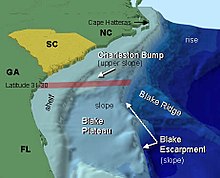South Atlantic Bight
This article needs additional citations for verification. (July 2022) |

The South Atlantic Bight is a bight in the United States coastline extending from Cape Hatteras, North Carolina to the Upper Florida Keys.[1] The Bight forms the western boundary of the Sargasso Sea and the Gulf Stream ocean current forms the eastern boundary of the ecosystem of the bight. Major cities along the bight include from north to south: Wilmington, Myrtle Beach, Charleston, Savannah, Jacksonville, St. Augustine, West Palm Beach, Fort Lauderdale, and Miami.
Bathymetry
The bight is fairly shallow with the continental shelf extending far offshore except off south Florida and North Carolina. The Blake Plateau forms a zone of intermediary depth before dropping to the Hatteras Abyssal Plain with the Blake Escarpment. The Escarpment is defined as the geological bathymetric eastern boundary of the bight. Within the northern plateau is the Charleston Bump which deflects the Gulf Stream northeastward from its initial northerly motion. Due to storms and unpredictable shoaling, the area off the North Carolina Outer Banks is known as the Graveyard of the Atlantic. The southern part of the bight borders the Bermuda Triangle where many aircraft and sea vessels have been lost off Florida from various causes. The seafloor of the bight contains various debris and discarded rocket components from decades of launches from Cape Canaveral. A notable spacecraft, the Liberty Bell 7 was recovered from the Blake Escarpment in 1999 after being lost. Debris from launches often washes up on shores as far as North Carolina after being dredged up by hurricanes and moved around by currents. [2]
Hurricanes

Hurricanes frequently make landfall along the bight except in Northern Florida and Georgia where seasonal steering patterns usually cause storms to recurve before encountering land in these areas. The warmer waters of the Gulf Stream allows storms to intensify before making landfall. Notable storms include hurricanes Hugo, Fran, Floyd, Isabel, Matthew, Florence, and Dorian in the Carolinas as well as hurricanes King, David, Francis, and Jeanne, in Florida. In the winter, Nor'easters begin their formation in the South Atlantic Bight as northeast moving low pressure systems carrying cold air from Canada encounter the warm waters of the Gulf Stream.
References
- ^ "U.S. Geological Survey Sea Floor Stress and Sediment Mobility Database South Atlantic Bight". USGS. USGS. Retrieved 15 June 2022.
- ^ Cassella, Carly (October 28, 2018). "SpaceX's rocket debris is washing up on beaches — and the company is being asked to clean up". Business Insider. Retrieved 27 June 2022.
